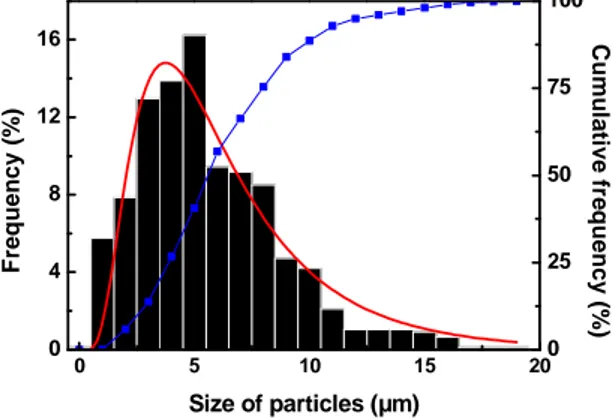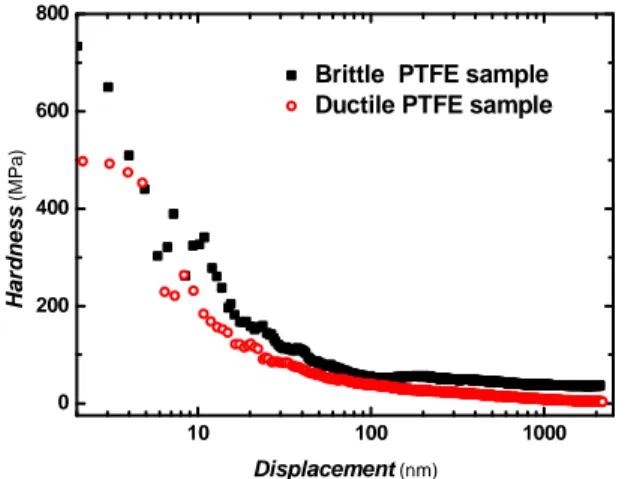Science Arts & Métiers (SAM)
is an open access repository that collects the work of Arts et Métiers Institute of Technology researchers and makes it freely available over the web where possible.
This is an author-deposited version published in: https://sam.ensam.eu
Handle ID: .http://hdl.handle.net/10985/11620
To cite this version :
I. EL ABOUDI, A. MDARHRI, Mohamed BENTOUMI, A. NOURDINE, M. EL AZHARI, Alex MONTAGNE, Alain IOST - Influence of processing conditions on nanoindentation properties of spark plasma sintered ptfe - 2016
Any correspondence concerning this service should be sent to the repository Administrator : archiveouverte@ensam.eu
Colloque Indentation 2016 12 – 14 Octobre 2016 Lille
Groupe d’Indentation Multi Echelle Nord Pas-de-Calais
INFLUENCE OF PROCESSING CONDITIONS ON NANOINDENTATION
PROPERTIES OF SPARK PLASMA SINTERED PTFE
I. El Aboudi1, A. Mdarhri2, M. Bentoumi3, A. Nourdine4, M. El Azhari2 , A. Montagne5 and A. Iost5
1
LCME Laboratory, FSTG Cadi Ayyad University. A. Khattabi, BP 549 40 000 Marrakesh, Morocco.
2
LMCN Laboratory, FSTG-Cadi Ayyad University, A. Khattabi Marrakesh BP 549 40 000, Morocco .
3
Laboratory of applied optics, Institute of Optics and Precision Mechanics, Sétif -1, Algeria 19000.
4
Université Savoie Mont Blanc, LEPMI, F-73000 Chambéry, France.
5
Arts & Metiers ParisTech; Mechanics, Surfaces and Materials Processing (MSMP), 8 boulevard Louis XIV, 59046 Lille, France.
Key words
PTFE, SPS process, Indentation size effect, Deformation Mechanisms
INTRODUCTION
The Spark Plasma Sintering (SPS) is considered as fast sintering route using self-heating action from inside the powder similar to microwave sintering and self-propagating high temperature. High sintering rate, low temperature processing, ease of operation and accurate control of sintering energy are the major advantages of this non-melting technique with regard to classical methods. The aim of this investigation is to take benefit from the advantages offered by the SPS process in order to sinter the polytetrafluoroethylene (PTFE) polymer materials from PTFE powder particles. The effect of the process’s parameters, namely the sintering temperature and heating rate, on the nano-indentation deformation is explored at room temperature. Empirical data on depth-dependent hardness are confronted to some theoretical models with a special focus on the apparent surface stress changes with the indentation depth. Furthermore, the obtained results are compared to the macro-behavior deduced from tensile and bending properties in order to assess the change in both surface and bulk deformations of the SPSed samples and according to the processing parameters.
EXPERIMENTAL
Fig.1. depicts the distribution of the particles sizes obtained from SEM observations that were carried out on the PTFE powder dispersed in the suitable surfactant (2-propanol). The average value of particles diameter is found to be about 5.44± 0.61 µm according to the Lorentzian law.
0 5 10 15 20 0 4 8 12 16 Size of particles (µm) F re q u e n c y ( % ) 0 25 50 75 100 C u m u la tiv e f re q u e n c y ( % )
Colloque Indentation 2016 12 – 14 Octobre 2016 Lille
Groupe d’Indentation Multi Echelle Nord Pas-de-Calais
The nanoindentation hardness experiments were performed by using a Berkovich indenter (Nano indenter XP MTS) with a force resolution of about 50 nN and displacement resolution of about
0.1 nm. For all experiments, the load was fixed in the range of 1.5-5 mN with a loading rate of 0.05s-1.
Four samples that are sintered by using the SPS method in which the temperature sintering and heating rate were used as processing variables were studied here [1]. For each sample six indentation tests were performed with good repeatability within 2% errors.
RESULTS AND DISCUSSION
Figure 2. plots typical curves of the depth-dependent hardness for two SPSed PTFE samples manufactured by two heating rate values: 1.3 and 1.6° C/s, while the sintering temperature was fixed at 360 °C. For this example, the average values of the hardness are found to be about 0.043 (brittle
sample) and 0.023 (ductile sample) GPa respectively indicating a strong effect of the processing
parameters on the nano-indentation behavior. In these micro/nanoscales, the polymer highlights size dependent properties [2]. Similar trend was highlighted in all sintered PTFE samples in which the dissipation energy is related to the surface roughness and bulk micro fibrils formation [3].
10 100 1000 0 200 400 600 800
Brittle PTFE sample Ductile PTFE sample
H a rd n e s s ( M P a ) Displacement (nm)
Figure 2: Hardness-displacement curves of PTFE samples sintered under heating rate of 1.3 (brittle sample) and 1.6 °C/s (ductile sample).
CONCLUSION
This study deals with the nano-indentation properties of PTFE polymer manufactured by a newly processing route (SPS). The hardness and elastic modulus of the PTFE materials are found to be strongly dependent on the processing parameters and highlighting size dependent properties. These results indicate that this fast and efficient technique can be used to tailor the nano-indentation behavior of the material as is seen in macro-behavior deduced from the tensile and bending tests. Surface effects and bulk properties of SPSed samples are examined by using both theoretical models and suitable probes such as profilometry and scanning electron microscopy.
References
[1] A. Mdarhri et al., Physical and mechanical features in Spark Plasma Sintered non-electrically
conductive PTFE polymer materials, submitted, 2016.
[2] B. N. Lucas, in: Thin-Films -- Stresses and Mechanical Properties VII 505, Materials Research Society, Pittsburgh, PA, p. 97, 1998.

